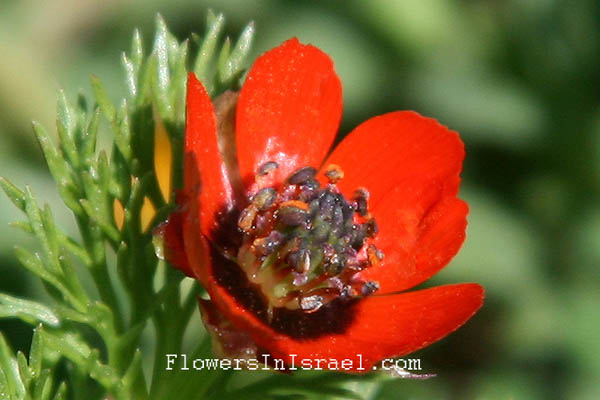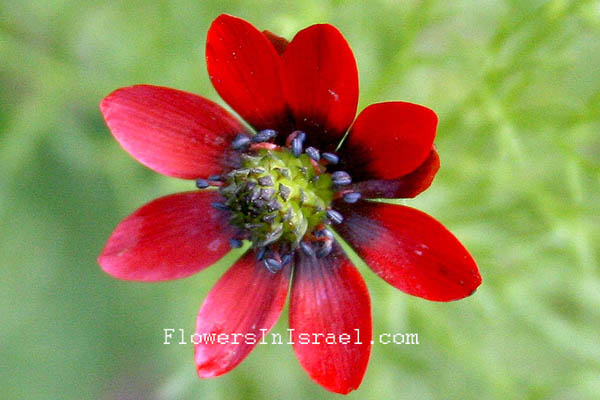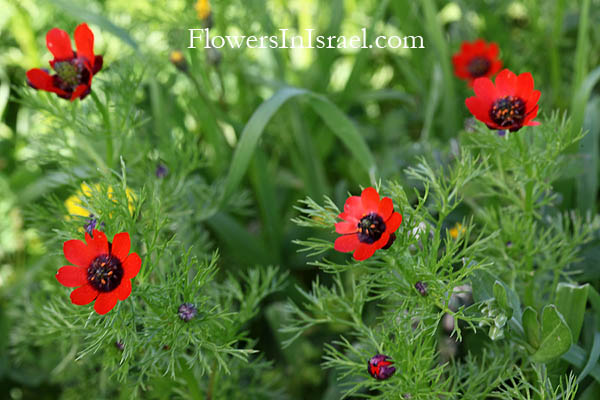Red Chamomile, Dmumit,
Hebrew: דמומית קטנת-פרי, Arabic: حنون البس
| Scientific name: | Adonis microcarpa DC. | |
| Synonym name: | Adonis cupaniana Guss. | |
| Common name: | Small pheasant's eye, Red Chamomile | |
| Hebrew name: | Dmumit, דמומית קטנת-פרי | |
| Arabic name: | حنون البس | |
| Family: | Ranunculaceae, נוריתיים |

|
| Life form: | Annual plants which survive the unfavourable season in the form of seeds and completes its life-cycle during favourable seasons; therophytes | |
| Stems: | Erect herb, branched, growing up to 60 cms high | |
| Leaves: | Alternate (one leaf per node), dissected, dissected twice or more, dentate or serrate | |
| Flowers: | Single flower, 5-8 red petals, black center | |
| Fruits: | Apocarpic fruit; cluster of green achenes, which grow up to 3-4mm each. Achenes are "monocarpellate" (formed from one carpel). | |
| Flowering Period: | February, March, April | |
| Habitat: | Batha, Phrygana | |
| Distribution: | The Mediterranean Woodlands and Shrublands, Semi-steppe shrublands, Shrub-steppes, Montane vegetation of Mt. Hermon | |
| Chorotype: | Mediterranean | |
| Summer shedding: | Ephemeral |

Derivation of the botanical name: Adonis, Αδωνιϛ, ιδοϛ, "god of plants", the Greek classical name; in Greek legend Adonis was a beautiful youth loved by both Aphrodite and Persephone "when Adonis died Zeus decreed that he should spend winters in the underworld with Persephone and spend summers with Aphrodite" Then, it came to pass that a boar killed Adonis. Upon learning the news, Aphrodite shed as many tears as the blood drops that had fallen from Adonis’s body. A rose bush grew from each one of Aphrodite’s tears, and a plant of that name from each drop of blood. dentata, toothed, with teeth. microcarpa, micros, μικροϛ, "small, little, short"; carpos, καρποϛ, "fruit"; meaning small fruits. cupaniana, after the Italian monk Francesco Cupani (1657 - 1710/1711), botanist and author of works on Sicilian plants. The Adonis flower, the pheasant's eye, called in French goute-de-sang, because it sprang from the blood of the gored hunter. The Hebrew word:דמומית, dmumit, from דם, blood. The Hebrew name refers to the red color as the blood of the flowers.
Greek mythology: Adonis was the offspring of the incestuous union of King Cinyras of Paphos, in Cyprus, with his daughter Myrrha. His beauty was a byword. Aphrodite and Adonis spent many hours together, as lovers do, hunting and telling tales. Ares, the son of Zeus and the god of savage warfare, or bloodlust, disguised as a wild boar, was jealous, rushed at Adonis who was out hunting on Mount Lebanon, and gored him to death before Aphrodite's eyes. From Aphrodite's tears over his bleeding corpse spring out of the ground red windflowers or anemones. Ovid (Publius Ovidius Naso, 43 BCE - 17 CE) - Metamorphoses X: 'Each passing year the memory of his death shall cause an imitation of my grief.
"Your blood, Adonis, will become a flower perennial. Was it not allowed to you Persephone, to transform Menthe's limbs into sweet fragrant mint? And can this change of my loved hero be denied to me?" Her grief declared, she sprinkled his blood with sweet-smelling nectar, and his blood as soon as touched by it began to effervesce, just as transparent bubbles always rise in rainy weather. Nor was there a pause more than an hour, when from Adonis, blood, exactly of its color, a loved flower sprang up, such as pomegranates give to us, small trees which later hide their seeds beneath a tough rind. But the joy it gives to man is short-lived, for the winds which give the flower its name, Anemone, shake it right down, because its slender hold, always so weak, lets it fall to the ground from its frail stem.' According to Greek mythology, Adonis was born and died at the foot of the falls in Apheca,the source for the River Adonis, Nahr Imbraham ("nahr" meaning 'river') near the ancient city of Jebail, east of the town Qartaba in Lebanon. He is thought to revive and die annually like a vegetation spirit. Adonis is a name for the Babylonian god Tammuz, none other than the Phoenician 'Adhon, which is the same in Hebrew. Tammuz is the fourth month of the Jewish year, corresponding to July. The name is derived from that Babylonian god, identified with Adonis : Then He brought me to the entrance of the gate of the LORD'S house which {was} toward the north;
and behold, women were sitting there weeping for Tammuz.Ezekiel 8:14 In the Bible God is sometimes referred to as Adon, though the term is used as a title, not as the personal name of God. The appellation "Adonai" (my Lord) became a substitution name for pronouncing in prayer the unutterable name God. Adonis and Aphrodite appear among the Phoenicians as Tammuz and Astarte and are identified with Osiris and Isis in Egypt. 
|